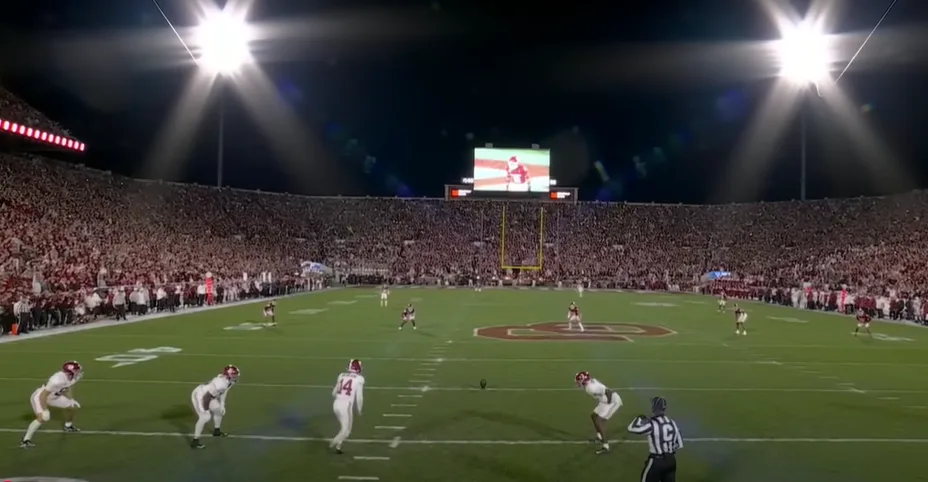The Phenomenon That Stops a Nation Every Saturday
There’s something uniquely American about the ritual that unfolds every autumn Saturday across college campuses nationwide. It’s the only sport on the planet in which 100,000 people will routinely make it a priority to show up any given Saturday to watch 18-year-olds chase their dreams. This isn’t just hyperbole – it’s the raw truth about college football’s unmatched ability to capture hearts, minds, and weekend schedules across the United States.
- The Phenomenon That Stops a Nation Every Saturday
- A Revolution in the Making: The 12-Team Playoff Era
- Week 1’s Historic Matchups: When Rankings Actually Matter
- The Cultural and Economic Engine
- The Betting Revolution and Fan Engagement
- Looking Beyond Week 1: The Season’s Broader Implications
- The Technology and Media Evolution
- The Future of College Football
- Conclusion: More Than Just Games
As Week 1 of the 2025 NCAA Football season kicks off, we’re witnessing something unprecedented in the sport’s 156-year history. The AP preseason poll was first introduced in 1950. 75 years later, the 2025 NCAA Football season will begin with three top-10 match-ups in Week 1. This historic convergence speaks to the evolving landscape of college football, where conference realignment, playoff expansion, and television contracts have created a perfect storm of competitive balance and national intrigue.
The numbers tell a compelling story about college football’s enduring appeal. While specific 2025 attendance figures won’t be available until the season progresses, recent historical data show that college football attendance rankings consistently feature programs drawing over 100,000 fans per game, with stadiums like Michigan’s “Big House” and Penn State’s Beaver Stadium regularly hosting crowds that would be the envy of professional sports.
A Revolution in the Making: The 12-Team Playoff Era
The 2025 season marks the second year of college football’s expanded playoff format, a change that has fundamentally altered the sport’s landscape. For the 2025 season, the four highest-ranked teams overall now receive first-round byes, regardless of conference champion status, with 12 teams selected to the Playoff field and the five highest-ranked conference champions earning automatic bids. This shift from the previous four-team format has created ripple effects throughout the sport, giving more programs legitimate hope while intensifying the competition at the highest level.
The playoff expansion hasn’t come without controversy or continued evolution. More than doubling the CFP could shrink ESPN’s interest in propping up bowls, especially with 30 non-CFP games scheduled for the 2025-26 season, as format and schedule changes remain necessary with further expansion on the horizon. The business implications are staggering – television rights, bowl game partnerships, and university revenue streams are all being recalibrated in real-time.
This evolution reflects college football’s unique position in American sports culture. Unlike professional leagues with salary caps and structured parity, college football’s ecosystem thrives on tradition, regional rivalries, and the pure unpredictability that comes with young athletes playing for pride, scholarships, and the dream of professional careers.
Week 1’s Historic Matchups: When Rankings Actually Matter
The opening of the 2025 season includes games that would otherwise be the preserve of a bowl game or late-season benchmarks. There will be a rematch of last year’s Cotton Bowl on Saturday at noon ET when No. 3 Ohio hosts top-ranked Texas. That was a win by the Buckeyes, and this victory led to their first national championship title since the year 2014. The cyclic quality of this game (the champion of the previous season versus the preseason favorite in Week 1 this year) is an illustration of how the old ways of telling the story of college football are being condensed and even enhanced.
These premier matchups are surrounded by uncertainty, as it is seen in the betting markets. Now, Texas is the highest-rated team in the AP poll, and Ohio State is the highest-rated team overall, but it is the Buckeyes making a small home favourite on Saturday at FanDuel. Provided the current line does not change, Longhorns would be the first AP preseason poll No. 1 to enter the season as a betting underdog. This statistical aberration highlights the manner in which the broadened playoff system has established new rules of perception and valuation of teams.
The star attraction that moves these matches goes beyond the rankings of the teams and moves to individual awards. Further contributing to the excitement of that Week 1 match-up is the star power with two of the four leading choices to win the Heisman Trophy competing in Buckeyes Stadium. That elite talent is now concentrated in these early-season games is a root cause of a paradigm shift, in that the traditional paradigm used to feature marquee players in bowl games months after their college careers had already technically been over.
The Cultural and Economic Engine
College football’s impact extends far beyond the stadium walls or television screens. The sport has become a multi-billion-dollar economic engine that drives entire communities, shapes university identities, and creates lifelong bonds among alumni scattered across the globe. The passion isn’t just about the games themselves – it’s about belonging to something larger than yourself, whether that’s the tradition-rich programs of the SEC, the academic prestige of Big Ten institutions, or the underdog spirit of smaller conferences fighting for recognition.
The modern college football experience has evolved into a comprehensive entertainment package. Tailgating has become an art form, with elaborate setups that rival professional catering operations. Stadium renovations have transformed these venues into architectural marvels, complete with luxury suites, premium dining options, and technology that rivals professional sports facilities. Yet at its core, the sport maintains its fundamental appeal: the raw emotion of young athletes competing at the highest level, representing not just themselves but entire communities and traditions.
The Betting Revolution and Fan Engagement
The integration of legal sports betting has added another dimension to college football’s appeal. Texas is the favourite to win the NCAA Football FBS Championship at +550 at FanDuel. Their SEC rival Georgia is a close second choice at +650. Then it’s Ohio State and Penn State both at +700. These odds reflect not just expert analysis but millions of dollars in public wagering, creating a real-time barometer of fan confidence and expectation.
The impact of betting extends beyond casual fans to the media coverage and analysis surrounding the sport. Pre-game shows now regularly feature betting advice, point spreads are discussed alongside traditional statistics, and the concept of “covering the spread” has become as important to many fans as winning the game outright. This evolution has created new vocabularies, new forms of engagement, and new revenue streams for everyone involved in the college football ecosystem.
Looking Beyond Week 1: The Season’s Broader Implications
As impressive as Week 1’s lineup appears, it’s merely the opening act in what promises to be a transformative season for college football. While a Week 1 win will be huge for either team, one loss on its own won’t stop either contender from getting to the 12-team playoff. This reality represents perhaps the most significant change in college football’s modern era – the expanded playoff format has reduced the penalty for early-season losses while simultaneously increasing the reward for strong regular-season performance.
The ripple effects of this change are still being understood. Traditional powerhouses can afford to schedule more challenging non-conference opponents without fear of playoff elimination. Smaller programs have more pathways to national relevance. Conference championships have taken on new meaning as automatic playoff qualifiers, while at-large berths create additional opportunities for deserving teams.
The human element remains college football’s greatest strength and most compelling storyline. These are student-athletes balancing academic responsibilities with athletic excellence, often carrying the hopes and dreams of entire communities on their shoulders. They’re 18-year-olds chasing their dreams, yet they’re performing on stages that rival any entertainment venue in America, with television audiences that exceed many professional sporting events.
The Technology and Media Evolution
The way fans consume college football has been revolutionized by streaming platforms, social media, and advanced analytics. TSN’s coverage of NCAA games represents the global appetite for American college sports, bringing these uniquely American traditions to international audiences who are discovering the sport’s unique blend of athleticism, pageantry, and passion.
Advanced metrics have changed how the sport is analyzed and understood. Terms like “strength of schedule,” “quality wins,” and “predictive rankings” have become part of the everyday fan vocabulary. The SEC has been vocal about more emphasis on schedule since Alabama was left out in 2024, highlighting how the expanded playoff format has created new debates about how teams should be evaluated and selected.
The Future of College Football
We are also watching a sport in transition as we watch this historic Week 1. Realignment of conferences has continued to realign conventional rivalries, where geographical aspects have been overshadowed by television revenues and competitive balance. The Name, Image, and Likeness (NIL) era has brought the professional aspect to college sports, but at the same time, the staffing of college football has remained the amateur touch of the sport.
The discussion on the expansion of the playoff has not ended yet, as far as in addition to the present 12-team playoff, it can be expanded to even larger numbers. Radical concept of expansion of the College Football Playoff by the Big Ten walks on the nerves of executives and interests of athletic directors, since expansion would pose a danger of making the meaning of regular-season games less valuable. Such debates capture the tension that is currently experienced between tradition and innovation in order to define modern college football.
Conclusion: More Than Just Games
Week 1 of the NCAA Football season 2025 is more than a reintroduction of Saturday afternoon amusement. It is the legacy of a cultural event that combines localities together, develops lifetime memories, and presents the ultimate amateur athletic competition worldwide. Combine the sport, gambling, culture, the nostalgia, and one can be excited to see college football resume.
When fans sink into their Saturday activities, be it finding reasons to avoid family duties, meeting their friends in sports bars, or riding a pilgrimage to the stadiums on campus, they are engaging in something truly American. The 2025 season is set to be historic not only due to the historic one-week-1 games, but also due to what it signifies with regard to the development of college sports in the 21st century.
Games will be played, new legends will be created, and winners will be crowned. Yet the true triumph lies in the fact that a tradition is carried on which brings the best out of competition and community, of the human spirit. In an ever-more technological and politically polarized world, college football stands as one of the few entities that can bring strangers together behind a common cause, form immediate friendships, and help us all remember why sports are important in our lives.





